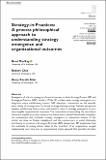Files in this item
Strategy-in-practices : a process philosophical approach to understanding strategy emergence and organizational outcomes
Item metadata
| dc.contributor.author | Mackay, Brad | |
| dc.contributor.author | Chia, Robert | |
| dc.contributor.author | Nair, Anup | |
| dc.date.accessioned | 2020-07-06T16:30:01Z | |
| dc.date.available | 2020-07-06T16:30:01Z | |
| dc.date.issued | 2020-06-20 | |
| dc.identifier | 267506251 | |
| dc.identifier | 39bb59a1-c813-4130-957a-da5e28c71d17 | |
| dc.identifier | 000542387500001 | |
| dc.identifier | 85086701523 | |
| dc.identifier.citation | Mackay , B , Chia , R & Nair , A 2020 , ' Strategy- in -practices : a process philosophical approach to understanding strategy emergence and organizational outcomes ' , Human Relations , vol. Online First , pp. 1-33 . https://doi.org/10.1177/0018726720929397 | en |
| dc.identifier.issn | 0018-7267 | |
| dc.identifier.other | ORCID: /0000-0001-8737-3018/work/82788684 | |
| dc.identifier.uri | https://hdl.handle.net/10023/20212 | |
| dc.description.abstract | Emergence of a firm’s strategy is of central concern to both Strategy Process (SP) and Strategy-as-Practice (SAP) scholars. While SP scholars view strategy emergence as a long-term macro conditioning process, SAP advocates concentrate on the episodic micro ‘doing’ of strategy actors in formal strategy planning settings. Neither perspective explains satisfactorily how process and practice relate in strategy emergence to produce tangible organizational outcomes. The conundrum of reconciling the macro/micro distinction implied in process and practice stems from a shared Substantialist metaphysical commitment that attributes strategy emergence to substantive entities. In this article, we draw on Process metaphysics and the practice-turn in social philosophy and theory to propose a Strategy-in-Practices (SIP) perspective. SIP emphasizes how the multitude of coping actions taken at the ‘coal-face’ of an organization congeal inadvertently over time into an organizational modus operandi that provides the basis for strategizing. Strategy, therefore, inheres within socio-culturally propagated predispositions that provide the patterned consistency that makes the inadvertent emergence of a coherent strategy possible. By demonstrating how strategy is immanent in socio-culturally propagated practices, the SIP perspective overcomes the troublesome micro/macro distinction implied in SP and SAP research. It also advances our understanding of how strategy emergence impacts organizational outcomes. | |
| dc.format.extent | 33 | |
| dc.format.extent | 501029 | |
| dc.language.iso | eng | |
| dc.relation.ispartof | Human Relations | en |
| dc.subject | Immanent strategy | en |
| dc.subject | Metaphysics | en |
| dc.subject | Outcomes | en |
| dc.subject | Process | en |
| dc.subject | Practice | en |
| dc.subject | Strategy emergence | en |
| dc.subject | HD28 Management. Industrial Management | en |
| dc.subject | T-NDAS | en |
| dc.subject | BDC | en |
| dc.subject | R2C | en |
| dc.subject.lcc | HD28 | en |
| dc.title | Strategy-in-practices : a process philosophical approach to understanding strategy emergence and organizational outcomes | en |
| dc.type | Journal article | en |
| dc.contributor.institution | University of St Andrews. School of Management | en |
| dc.contributor.institution | University of St Andrews. Office of the Principal | en |
| dc.identifier.doi | 10.1177/0018726720929397 | |
| dc.description.status | Peer reviewed | en |
This item appears in the following Collection(s)
Items in the St Andrews Research Repository are protected by copyright, with all rights reserved, unless otherwise indicated.

